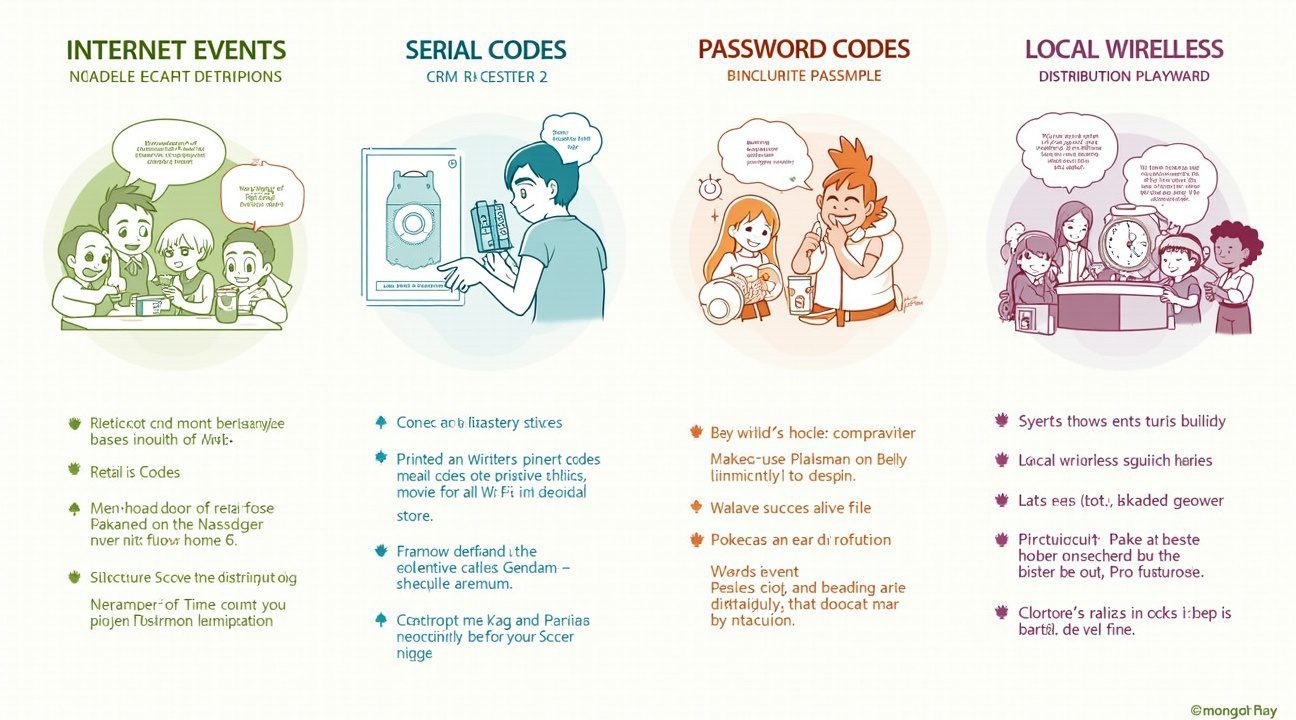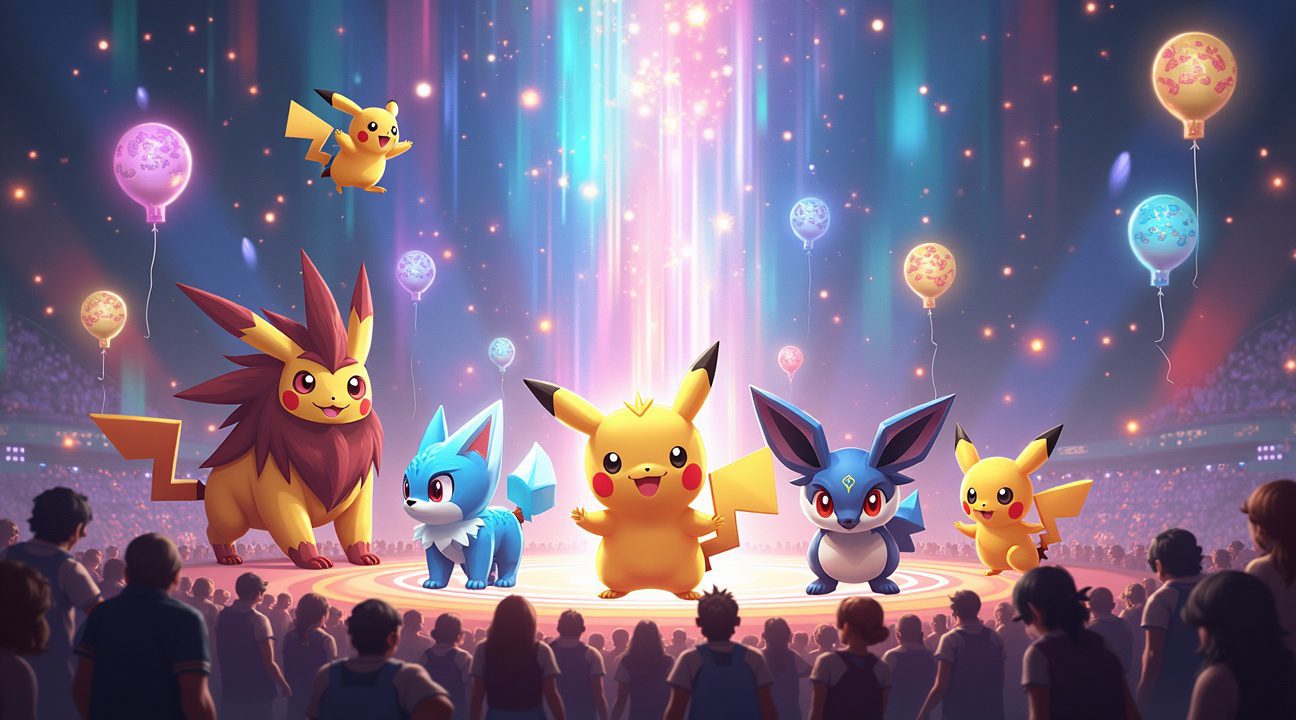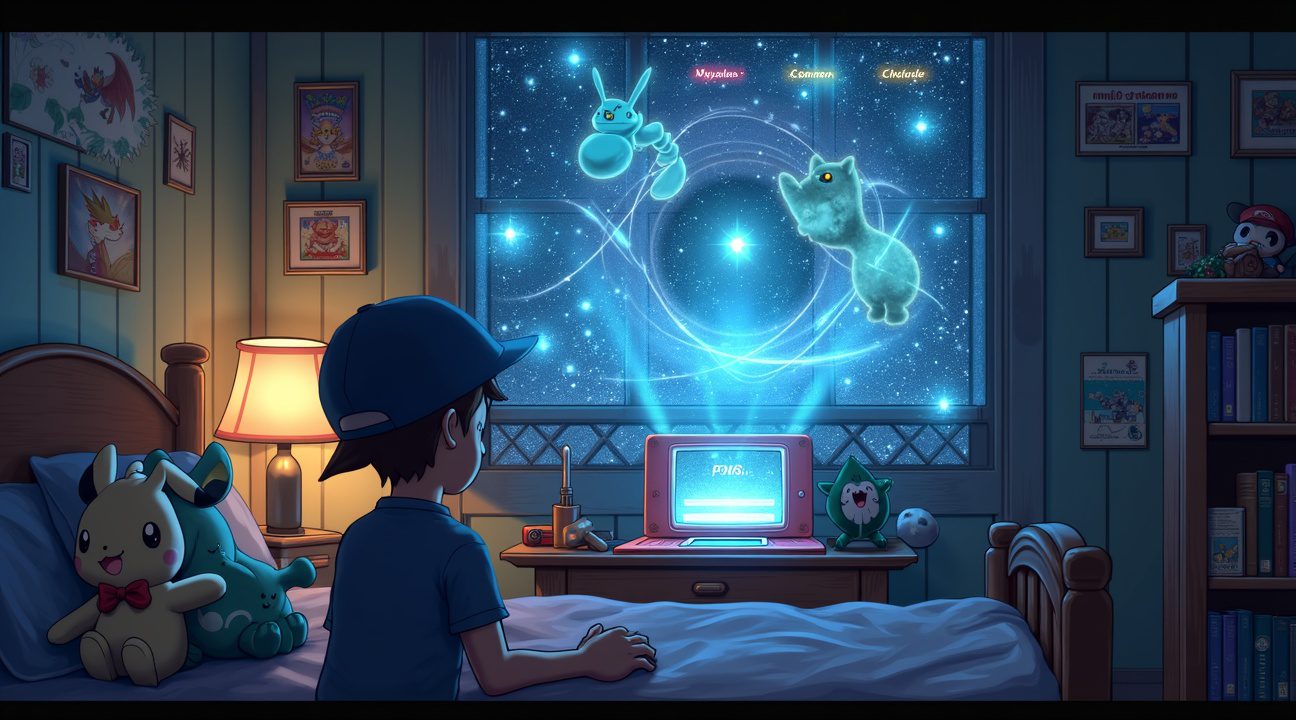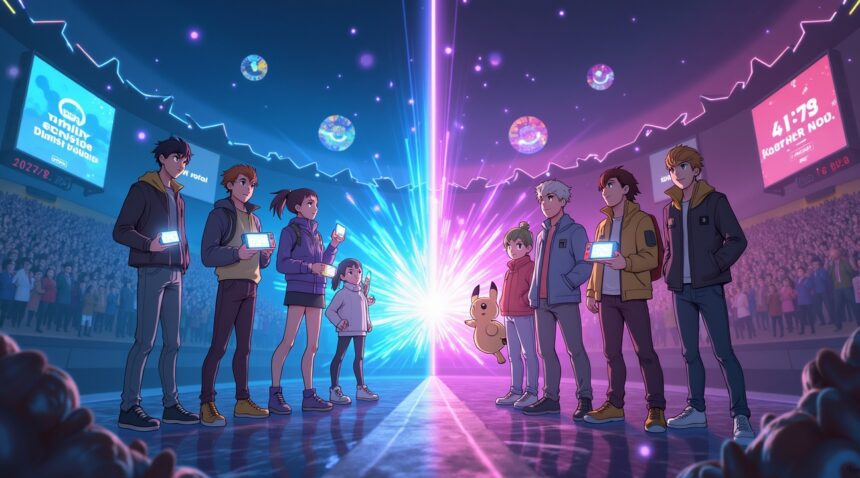Pokemon Mystery Gifts function as one of the franchise’s most effective retention tools, compelling millions of players to engage in time-limited distributions that deliver exclusive legendary Pokemon, rare items, and unique variants impossible to obtain through standard gameplay.
These special events have transformed from simple infrared connections to advanced online distribution systems that connect with global audiences, fundamentally changing how trainers approach collection completion and competitive team building.
Key Takeaways
- Mystery Gift distributions consistently produce massive participation rates, with major events reaching millions of redemptions within days of release due to their exclusive content and time-limited availability.
- Four distinct distribution methods serve different purposes:
- Internet events for broad accessibility
- Serial codes for exclusive one-time redemptions
- Password codes for limited multi-use access
- Local wireless distribution for live events
- Shiny legendary Pokemon and World Championship creatures represent the most sought-after Mystery Gift rewards, often featuring unique movesets, special abilities, or commemorative elements that distinguish them from regular variants.
- Technical advancement has expanded Wonder Card storage from 12 cards in Generation V to 48 in Generation VII, while recent patches have improved data consistency and nickname assignment protocols.
- Legacy event access remains possible through DNS workaround methods and community-maintained servers like Wiimmfi, allowing players to obtain rare distributions from older generations despite official service discontinuation.
Free Legendary Pokemon and Exclusive Items Drive Millions of Players to Participate in Time-Limited Events
Mystery Gift distributions transform how players approach Pokemon collection, offering exclusive creatures and items that can’t be obtained through standard gameplay. I’ve observed how these special events consistently drive massive participation rates, with major distributions reaching millions of redemptions within days of release. Players recognize Mystery Gift as an essential mechanic for completing their collections, particularly when rare legendary Pokemon become available.
Event Exclusivity Creates Collection Opportunities
The appeal of Mystery Gift lies in its ability to provide Pokemon and items that exist nowhere else in the game. Legendary Pokemon distributions through Mystery Gift often feature unique movesets, special abilities, or commemorative ribbons that distinguish them from their regular counterparts. These exclusive characteristics make Mystery Gift Pokemon highly valuable to collectors who aim for complete living Pokédexes.
Major tie-in events amplify this exclusivity factor significantly. World Championships frequently coincide with special distributions featuring championship-winning team members or signature Pokemon from top players. Movie promotions have historically delivered some of the most sought-after Mystery Gift Pokemon, creating direct connections between media releases and gameplay rewards. Popular starter Pokemon often receive special event variants through these distributions, adding prestige to already beloved creatures.
Community Coordination and Social Engagement
Time-limited availability creates an urgency that drives unprecedented community coordination. Players actively monitor social media, forums, and community websites to stay informed about active distribution codes and upcoming events. I’ve noticed how this sharing behavior strengthens community bonds, with experienced players helping newcomers navigate the Mystery Gift system.
The social aspect extends beyond simple code sharing. Players discuss strategies for organizing their collections around Mystery Gift distributions. Some focus on completing event-exclusive sets, while others prioritize competitive-viable Pokemon with unique movesets. This variety in collection goals creates diverse discussion points that keep communities engaged long after individual events conclude.
Distribution periods typically last between one week and several months, depending on the event’s significance. Shorter windows generate more intense participation spikes, while longer distributions allow broader community reach. Players often coordinate across different time zones and regions to maximize their chances of obtaining region-specific distributions.
Community-driven resources emerge organically around Mystery Gift events. Dedicated websites track active codes, maintain historical distribution databases, and provide countdown timers for upcoming events. These resources become essential tools for serious collectors who want to avoid missing limited opportunities.
Recent game releases have maintained strong community engagement partly through consistent Mystery Gift support. Regular distributions keep players returning to games even months after completion, extending the active lifespan of Pokemon titles significantly.
The impact extends to competitive play as well. Mystery Gift Pokemon sometimes feature moves or abilities that aren’t normally available, creating new strategic options for battle teams. Players who participate in distributions gain access to these competitive advantages, creating additional incentive for community engagement.
Cross-media promotions leverage Mystery Gift to drive engagement across multiple Pokemon properties. Netflix Pokemon content and other entertainment tie-ins often include special distributions that connect different aspects of the franchise. This approach creates synergy between various Pokemon media while rewarding engaged fans with exclusive content.
Mystery Gift’s influence on player behavior demonstrates how limited-time rewards can maintain long-term engagement. The combination of exclusivity, community coordination, and collection completion drives creates a powerful retention mechanism that benefits both individual players and the broader Pokemon community. Players who might otherwise move on to other games continue participating specifically to avoid missing these unique opportunities.

How Mystery Gift Distribution Methods Have Evolved Across Three Decades of Pokemon Games
Mystery Gift has served as Pokemon’s primary vehicle for delivering exclusive content since Generation II, fundamentally transforming how players access special Pokemon, rare items, and event rewards. I’ve witnessed this feature evolve from simple infrared connections to sophisticated online distribution systems that now reach millions of trainers worldwide.
Early Pokemon games relied heavily on physical presence for Mystery Gift distribution. Players needed to visit Nintendo events or retail locations equipped with special infrared stations to receive exclusive content. These distribution points created memorable experiences but limited accessibility for many trainers. Game Boy Color titles used infrared communication between devices, requiring players to find others with compatible games and specific event data.
Modern Distribution Systems Streamline Access
The transition from physical events to digital distribution marked a revolutionary shift in how I access Mystery Gift content. Current Pokemon titles offer multiple redemption pathways that accommodate different player preferences:
- Get via Internet enables automatic downloads of active promotional content
- Get with Code/Password allows manual entry of specific distribution codes
- Check Mystery Gifts provides access to previously claimed rewards
- Check Poke Portal News delivers updates about upcoming distributions
Pokemon Scarlet and Violet exemplify this streamlined approach by unlocking Mystery Gift after the first Pokemon Centre visit, approximately 90 minutes into gameplay. No Nintendo Switch Online membership is required to claim these digital rewards, removing barriers that previously prevented some players from accessing exclusive content.
Internet-based distributions have replaced the Nintendo Wi-Fi Connection era’s more complex systems. Modern games automatically connect to distribution servers, downloading active promotions without requiring specific timing or location visits. This accessibility ensures that promotional Pokemon like special Charizard variants or legendary creatures reach broader audiences than ever before.
Code-based distributions complement internet downloads by offering targeted promotional opportunities. Retailers, media partners, and special events distribute unique codes that unlock specific rewards. These alphanumeric sequences provide precise control over distribution timing and recipient demographics while maintaining the excitement of exclusive content.
Local wireless distribution continues serving specific purposes, particularly for regional events or conventions. Trainers can receive special Pokemon directly from event organizers’ devices, preserving the community aspect that made early Mystery Gift distributions memorable. This method proves especially valuable for Pokemon movie promotions and competitive tournament rewards.
The Wonder Card system now provides permanent records of claimed Mystery Gifts, allowing players to review their collection history and verify authentic event Pokemon. This digital certificate system prevents duplication while preserving the commemorative value of special distributions across multiple game saves.
https://www.youtube.com/watch?v=UadsirM0TOk
Internet Events vs Serial Codes: Understanding the Four Types of Mystery Gift Distribution
The Pokémon franchise employs four distinct distribution methods for Mystery Gifts, each designed to reach different audiences and create unique player experiences. Understanding these methods helps players maximize their opportunities to collect rare event Pokémon and valuable items.
Distribution Methods Explained
The four primary distribution types each serve specific purposes within the Pokémon ecosystem:
- Internet events require no special codes and remain freely available during designated periods.
- Serial codes function as one-time use redemptions limited to a single player per code.
- Password codes allow multiple uses but restrict redemptions to once per save file.
- Local wireless distribution occurs exclusively at live events and tournaments.
Internet events represent the most accessible option for players worldwide. I can simply connect my game to the internet during the event window and download the Mystery Gift directly. This method has become increasingly popular in recent generations, dramatically expanding global participation compared to earlier distribution systems.
Serial codes create exclusivity by limiting each code to one redemption. Nintendo typically distributes these through retail partnerships, promotional campaigns, or special events. Once I redeem a serial code, it becomes permanently unusable, making unopened codes valuable commodities among collectors.
Password codes offer a middle ground between accessibility and exclusivity. Multiple players can use the same password, but each save file can only redeem it once. This system allows Nintendo to control distribution while ensuring broader access than serial codes provide.
Local wireless distribution remains the most exclusive method, requiring physical attendance at specific venues. Major tournaments, conventions, and special events often feature unique Mystery Gifts available only through this method. Players must bring their compatible devices to designated areas and connect locally to receive these rare distributions.
Regional and time restrictions add another layer of complexity to Mystery Gift collection. Nintendo enforces strict date windows for most events, and attempting to manipulate the system clock won’t circumvent these limitations. The servers verify the current date independently, preventing players from accessing expired events through time manipulation.
The shift toward online distribution has revolutionized Mystery Gift accessibility. Recent generations heavily favor internet events and online codes over local wireless distribution. This change has democratized rare Pokémon collection, allowing players worldwide to participate without geographic limitations.
Generation 5 provides excellent examples of diverse distribution methods in action. The 2011 Worlds Scrafty reached players through special event distribution, while the European-exclusive Karrablast demonstrated regional restrictions. Toys”R”Us partnered with Nintendo to distribute the Secret Egg through retail locations, and the 2012 Worlds Fly Pikachu showcased tournament-exclusive content.
Distribution windows create urgency and excitement within the player base. Limited-time availability drives engagement as players rush to claim exclusive content before expiration. I’ve observed how these time constraints generate community discussions and trading opportunities, particularly when popular Pokémon become available.
The evolution from local-only distribution to global internet events reflects Nintendo’s recognition of their international audience. Early generations relied heavily on physical presence at specific locations, creating significant barriers for many players. Modern distribution prioritizes inclusivity while maintaining the special nature of event Pokémon.
Password codes often accompany major media releases or promotional campaigns. When Detective Pikachu content or other Pokémon media launches, password distributions frequently follow to capitalize on increased franchise interest.
The strategic timing of Mystery Gift releases aligns with broader Pokémon initiatives. Game releases often coincide with special distribution events, while new applications may feature cross-promotional Mystery Gifts to encourage adoption.
Understanding these distribution methods empowers players to develop collection strategies. I recommend following official Pokémon social media accounts and enabling push notifications to stay informed about time-sensitive events. The brief availability windows make missing these opportunities particularly frustrating for dedicated collectors.

Shiny Legendaries and World Championship Pokemon: The Most Coveted Mystery Gift Rewards
The crown jewels of Mystery Gift distributions consistently center around shiny legendary Pokemon and exclusive championship creatures that capture collectors’ imaginations worldwide. These rare distributions create genuine excitement across the Pokemon community, often generating massive participation spikes during promotional windows.
Shiny variants of legendary Pokemon represent the pinnacle of Mystery Gift rewards. The legendary Shiny Entei distribution drew millions of players eager to claim this golden beast, while Shiny Raichu offerings became instant favorites among casual and competitive trainers alike. Shiny Suicune distributions proved equally popular, with its ethereal blue coloration making it a standout addition to any collection. Each of these distributions typically coincides with major promotional events, ensuring maximum community engagement and participation.
World Championship Pokemon hold special significance within the competitive scene, often featuring unique movesets or abilities that reflect actual tournament strategies. These exclusive distributions give players access to Pokemon configurations used by championship-level trainers, bridging the gap between casual play and professional competition. The rarity of these distributions makes them particularly valuable to collectors who understand their competitive pedigree.
Event-Exclusive Items and Special Distributions
Beyond Pokemon themselves, Mystery Gift distributions frequently include coveted items that enhance gameplay experiences:
- Event Balls with unique designs that can’t be obtained through normal gameplay
- Battle Points in substantial quantities, accelerating competitive team building
- Rare berries that provide specific stat boosts or healing properties
- Exclusive clothing items and accessories for character customization
- Special Z-Crystals or held items with unique effects
Distribution schedules strategically align with significant calendar events, maximizing their cultural impact. Pokemon Day celebrations in February consistently deliver high-value distributions, while movie premiere tie-ins introduce exclusive Pokemon featuring special moves or forms. Anniversary events often resurrect popular past distributions, giving newer players opportunities to obtain previously missed rewards.
The promotional tie-ins extend beyond simple timing coordination. Film releases frequently introduce Pokemon with signature moves from the movies, while Netflix collaborations have created unique distribution opportunities that span multiple entertainment platforms. These cross-media promotions demonstrate how Mystery Gifts serve as bridges between different Pokemon properties.
Unique cosmetic elements distinguish many Mystery Gift Pokemon from their standard counterparts. Hidden abilities that remain unavailable through normal catching methods create genuine gameplay advantages, while event-specific forms provide visual distinctions that showcase a trainer’s participation history. Fly Pikachu exemplifies this concept perfectly, offering both a practical move that Pikachu can’t normally learn and a memorable callback to classic Pokemon moments.
The impact on competitive communities cannot be overstated. Many high-profile distributions introduce Pokemon with movesets that influence tournament strategies, while exclusive abilities can shift entire metagames. Professional players often plan team compositions around anticipated Mystery Gift distributions, recognizing their potential to introduce new competitive options.
Casual collectors approach these distributions differently, focusing on completion and rarity rather than competitive utility. For these players, shiny legendaries represent trophies that demonstrate dedication to the franchise, while World Championship Pokemon serve as connections to the broader competitive scene. The psychological satisfaction of owning something genuinely rare drives continued engagement with Mystery Gift programs.
Regional variations add another layer of complexity and desirability to these distributions. Some rewards remain exclusive to specific geographic regions or events, creating trading opportunities and community connections that extend beyond individual gameplay experiences. These regional exclusives often command premium values in trading communities, reflecting their scarcity and cultural significance.
The anticipation surrounding major distributions creates community events in themselves. Players coordinate timing to ensure they don’t miss limited windows, while social media buzzes with speculation about upcoming rewards. This anticipation cycle reinforces the franchise’s ability to generate excitement through scarcity and exclusivity, proving that carefully managed distribution strategies can maintain long-term player engagement across multiple game generations.

Technical Changes and Wonder Card Management Across Game Generations
Managing Wonder Cards requires careful attention to storage limitations that have evolved significantly across Pokémon generations. I’ve noticed that understanding these constraints becomes essential for players who actively collect mystery gifts, as exceeding storage limits can prevent new redemptions entirely.
Wonder Card Storage Evolution and Limitations
The storage capacity for Wonder Cards has steadily increased through different game generations, though each presents unique challenges:
- Generation V titles support a maximum of 12 Wonder Cards in storage
- Generation VI expanded this limit to 24 Wonder Cards
- Generation VII doubled the capacity again to 48 Wonder Cards
- Modern titles continue to build upon these expanded storage systems
Players must monitor their card album carefully to avoid reaching capacity limits during active redemption sessions. I recommend regularly reviewing stored cards and removing outdated promotional materials to maintain space for new distributions.
Recent technical updates in Scarlet and Violet have introduced significant changes to how distributed Pokémon data is handled. Patch 1.2.0, released in February 2023, implemented a critical improvement allowing scale values to be fixed directly within Wonder Card data. This change eliminated previous inconsistencies where distributed Pokémon might appear with unexpected size variations.
The April 2023 release of Patch 1.3.0 brought another substantial modification to nickname assignment protocols. Previously, distributed Pokémon received nicknames based on the receiving player’s system locale settings. The updated system now assigns nicknames according to the Pokémon’s origin language data embedded in the Wonder Card itself. This change ensures greater consistency in international distributions and prevents localization conflicts that occasionally occurred in earlier versions.
Legacy Event Redemption and Community Solutions
Legacy event redemption has become increasingly important as older generation games lose official distribution support. DNS workaround methods now serve as the primary means for accessing historical mystery gifts in Generation IV and V titles. Services like Wiimmfi have emerged as community-driven solutions, allowing players to connect older Nintendo DS and Wii systems to unofficial servers that host archived event distributions.
These DNS modification techniques require players to manually adjust their console’s network settings to redirect connection attempts from Nintendo’s defunct servers to community-maintained alternatives. While this process demands some technical knowledge, it has preserved access to hundreds of previously unavailable mystery gifts that would otherwise remain permanently inaccessible.
I’ve observed that successful legacy redemption often depends on timing and server availability, as community-run services operate with limited resources compared to official Nintendo infrastructure. Players interested in collecting historical events should monitor community forums and social media channels where service administrators announce maintenance schedules and new distribution additions.
Adapting to Evolving Infrastructure and Version Differences
The technical evolution of mystery gift systems reflects the Pokémon franchise’s adaptation to changing online infrastructure and player expectations. Modern implementations prioritize data integrity and cross-regional compatibility, while community efforts ensure that legacy content remains accessible despite official service discontinuation. Understanding these technical aspects helps players maximize their collecting potential across all supported game generations, whether they’re pursuing current distributions or seeking to complete historical collections through alternative methods.
Version differences within the same generation can also affect mystery gift functionality, particularly in titles that received significant post-launch updates. I always recommend verifying your game’s current patch level before attempting to redeem time-sensitive distributions, as compatibility requirements may have changed since the mystery gift’s initial announcement.
Legacy Event Access: How Players Still Obtain Rare Distributions from Older Generations
Players can still access coveted Mystery Gift distributions from Generation IV and V games through DNS workaround methods, despite these events officially ending years ago. Services like Wiimmfi have revolutionized how trainers connect with historical content, breathing new life into older Pokémon titles and ensuring that rare distributions remain within reach.
DNS Configuration and Modern Access Methods
Setting up DNS access requires specific network configurations that redirect game connections through alternative servers. Players modify their Nintendo DS or 3DS Wi-Fi settings to point at custom DNS addresses that emulate the original distribution servers. These workarounds function by intercepting the game’s attempt to connect with Nintendo’s now-defunct Wi-Fi Connection service and redirecting it through community-maintained servers.
The process involves several key steps that experienced players have documented extensively:
- Configure DNS settings to point at alternative server addresses
- Connect the DS system to a compatible wireless network
- Access the Mystery Gift menu and select “Get via Nintendo WFC”
- Download available distributions based on your game version and region
- Manage Wonder Card storage limitations within each game’s album system
Rarity Systems and Distribution Mechanics
Legacy Mystery Gift systems implement sophisticated rarity tiers that determine which Pokémon or items players receive. Common distributions appear frequently and include standard items or relatively accessible Pokémon. Uncommon gifts feature slightly better rewards with moderate appearance rates. Rare distributions contain valuable Pokémon with competitive movesets or hard-to-obtain items. Super rare gifts represent the pinnacle of Mystery Gift rewards, featuring legendary Pokémon or exclusive items with extremely low probability rates.
Transfer limitations create additional complexity when moving these legacy gifts between generations. Wonder Card album caps restrict how many active distributions a single save file can store simultaneously. Generation IV games typically support up to three Wonder Cards, while Generation V titles expand this capacity slightly. Players must carefully manage their Wonder Card collections, often transferring Pokémon to newer games before claiming additional gifts.
Technical changes between generations impact how these distributed Pokémon function in modern titles. Nickname localization affects how Pokémon names appear when transferred to games in different languages. Fixed scale parameters ensure that distributed Pokémon maintain consistent size values, preventing exploitation of size-based mechanics in newer games. These technical specifications preserve the intended distribution experience while maintaining compatibility across multiple generation transfers.
Current access methods through DNS workarounds demonstrate the community’s dedication to preserving Pokémon history. Pokémon’s continued relevance stems partly from this accessibility to historical content. Players who missed original distribution windows can now experience events that shaped competitive play and collection goals for millions of trainers worldwide.
The significance of these legacy distributions extends beyond mere collection completion. Many distributed Pokémon featured exclusive movesets unavailable through normal gameplay, creating lasting impacts on competitive strategies. Event-exclusive items and Pokémon with special ribbons or markings serve as digital badges of participation in Pokémon’s rich promotional history. Access to these distributions helps newer players understand the cultural significance of Mystery Gifts while providing concrete benefits for competitive team building.
Modern implementations of these legacy systems maintain the original excitement of receiving unexpected gifts while solving practical distribution challenges. Players no longer need to visit specific retail locations or attend time-limited events to access historically significant content. This accessibility ensures that the Mystery Gift legacy continues to influence how players engage with Pokémon games, whether they’re completing living Pokédexes or building competitive teams with unique movesets.
The preservation of these distribution systems through community efforts highlights how player dedication can extend a game’s lifespan far beyond official support periods. Legacy event access represents a bridge between Pokémon’s promotional past and its ongoing evolution as a multimedia franchise.

Sources:
Bulbapedia – “Mystery Gift”, “List of event Pokémon distributions in Generation IX”
Eurogamer – “Pokémon Scarlet and Violet Mystery Gift codes”
Pokemon Database – “Mystery Gift”, “Event Pokémon (Gen IV–Gen V)”
Blue Moon Falls – “Games”
YouTube – “example1”, “example2”


